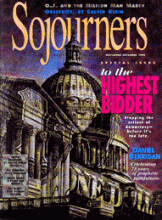FIVE MINUTES BEFORE soccer practice starts, four or five kids sit in the corner of the field, passing cards back and forth and negotiating trades.
"I'll give you Leviathan for Northern Paladin and Shapeshifter."
"No, Leviathan takes too much mana to bring out. How about Carrion Ants and Shapeshifter?"
"Done."
Most people who are reading this probably don't know this language, but many people all over the country (mostly age 10 and older) are starting to learn it by playing Magic: The Gathering
.
Magic
, as most people call it, is a "collectible card game." It incorporates some aspects of both baseball cards and a board game (except it doesn't have a board). Players buy decks of random cards, not knowing which ones will be inside each pack. More valuable cards are less common, and therefore less likely to be obtained in any given pack of cards. Players then construct a playing deck, which they use to "duel" another person, using spells, creatures, artifacts, and the like.
It is a very complex and intricate game, but very intriguing. Each game is different, so the possibilities are endless. I found myself hooked into the game after buying one deck and liking it. Obviously, many people find it fun and interesting, for Wizards of the Coast, the group that created the game, has sold more than a billion cards in just two years.
A common concern is the aspect of violence, since the object of the game is to kill your opponent. Also, some cards have evil-looking illustrations, while others have evil names, such as Demonic Consultation. (Note: Wizards of the Coast, in their latest revision of the card set, has eliminated all cards that have the words "demon" or "demonic" on them. Fortunately, cards such as these are in the minority, by far. Only five cards out of 300 needed to be deleted).
Read the Full Article
